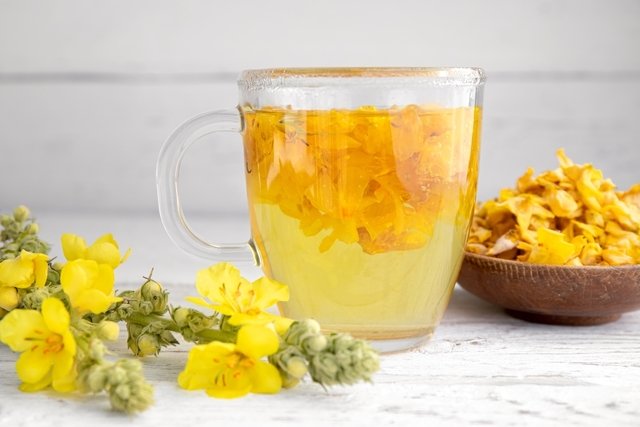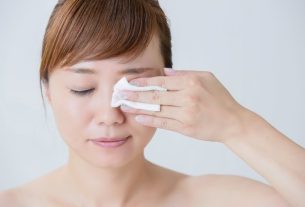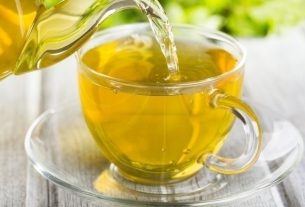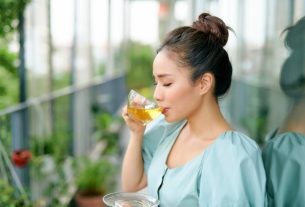Mullein is a medicinal plant, of the species Verbascum phlomoides or Verbascum thapsuswidely used to help treat respiratory problems, such as asthma and bronchitis, for example, as it has anti-inflammatory and expectorant properties.
The normally used parts of mullein, which is also known as mullein, are the flowers, leaves or roots, from which substances with medicinal properties are extracted for the preparation of tea, essential oil, aqueous extract or capsules.
Mullein can be found in health food stores or compounding pharmacies and should be used with medical advice or from a professional specialist in medicinal plants.

What is it for
Mullein is indicated to help in the treatment of:
1. Respiratory diseases
Mullein flowers are rich in verbacosides, saponins and iridoid glycosides with anti-inflammatory and expectorant properties, and can therefore be used to help treat respiratory diseases, such as asthma, bronchitis, spasmodic cough, tuberculosis or whooping cough, for example.
2. Colds and flu
Due to the saponins, flavonoids and iridoids in its composition with anti-inflammatory and antioxidant properties, mullein can help fight flu and colds.
In addition, mullein has phenylethanoid glycosides, with antiviral properties that help eliminate viruses that cause colds and flu, accelerating recovery.
3. Diarrhea
Mullein can also help relieve diarrhea, gastrointestinal cramps or intestinal bleeding, due to its antispasmodic and anti-inflammatory action.
Furthermore, a study (1) carried out in the laboratory showed that mullein has antimicrobial action, against bacteria such as E. coli e Staphylococcus aureus, which can cause intestinal infections. However, studies in humans are still needed to prove this benefit.
4. Gastritis
Mullein can help alleviate the symptoms of gastritis, such as nausea, vomiting or stomach pain, as it has anti-inflammatory, antioxidant and antispasmodic actions.
5. Headache
Mullein can also be used to relieve headaches, as it has anti-inflammatory properties, as well as having a sedative and calming effect.
6. Fluid retention
Mullein has a diuretic action, which helps to increase the elimination of fluids from the body through urine, combating fluid retention.
7. Skin wounds
Mullein leaves, when used on the skin, can accelerate the healing of wounds, burns, bruises, phlebitis and skin infections.
Furthermore, as it has anti-inflammatory, antioxidant and emollient action, mullein helps to recover, soften and protect the skin, accelerating recovery from wounds.
8. Hemorrhoids
Due to its anti-inflammatory properties, mullein can also be applied to external hemorrhoids, helping to alleviate symptoms such as pain, redness or anal itching.
9. Rheumatic diseases
Mullein can be used to help treat rheumatic diseases, such as gout, due to its anti-inflammatory and antirheumatic action, which helps to relieve joint pain.
10. Earache
Mullein essential oil can help fight ear pain caused by infections, such as otitis, for example.
How to use
Mullein can be used in the form of tea, aqueous extract, poultice or essential oil, which are made using the leaves, flowers or root of this plant.
1. Mullein tea
One of the most consumed forms of mullein is tea, which can be made with dried leaves of this plant, to help with respiratory illnesses, flu, colds or gastrointestinal problems.
Ingredients
- 2 tablespoons of dried mullein leaves;
- 1 liter of water.
Preparation mode
Bring the water to a boil, and when it is boiling, turn off the heat and add the dried mullein leaves, letting it rest for about 10 minutes. Then strain, wait for it to cool and drink up to 3 cups of tea per day.
2. Mullein essential oil
Mullein flower essential oil (I’ve got a bunch of Spanish) without alcohol can be used to relieve ear pain.
To use mullein oil, apply 1 to 3 drops of the oil to a piece of cotton and place it in the affected ear, up to 3 times a day, or as directed by your doctor.
Preferably, you should heat the oil before applying it to your ear, taking care to test the temperature on the back of your hand, to avoid burning your ear.
3. Mullein Aqueous Extract
Aqueous extract of mullein leaves (I’ve got a bunch of Spanish) can be used orally, diluted in water.
To prepare, add 1 to 2 mL of the aqueous extract of mullein leaves to 100 mL of water, mixing well, and take up to 3 times a day. The maximum dose per day should not exceed 6 mL of the aqueous extract.
4. Mullein Poultice
Mullein leaf poultice can be used to help heal non-bleeding wounds, bruises, burns, phlebitis, skin infections or gout.
Ingredients
- Fresh mullein leaves;
- Water.
Preparation mode
Wash the fresh mullein leaves and then add them to a container with a little water and bring to a boil for about 5 minutes. Then, wait for it to warm, squeeze the leaves to remove excess water, and apply them to the affected skin or joint.
5. Mullein Capsules
Mullein leaf capsules should be taken orally, with a glass of water, and doses should be advised by a doctor or herbalist, as there are capsules of various strengths.
Possible side effects
The side effects of mullein are allergic reactions, which can cause itching on the body, especially on the hands, arms or neck, when this plant is used in larger quantities than recommended.
Who shouldn’t use
Mullein should not be used by pregnant or breastfeeding women, or by people who are allergic to this plant.
In the case of children, mullein essential oil for ear pain appears to be safe when used for a short time and with medical advice. However, other ways of using mullein for children should be avoided, as there are not enough studies on its safety.

Sign up for our newsletter and stay up to date with exclusive news
that can transform your routine!
Warning: Undefined array key "title" in /home/storelat/public_html/wp-content/plugins/link-whisper-premium/templates/frontend/related-posts.php on line 12
Warning: Undefined array key "title_tag" in /home/storelat/public_html/wp-content/plugins/link-whisper-premium/templates/frontend/related-posts.php on line 13



